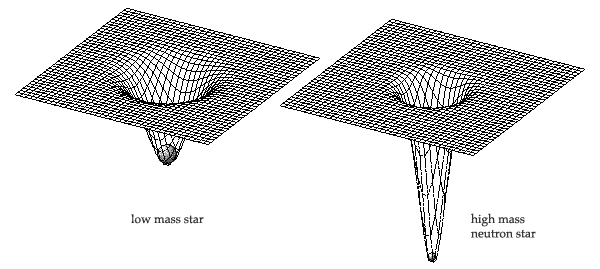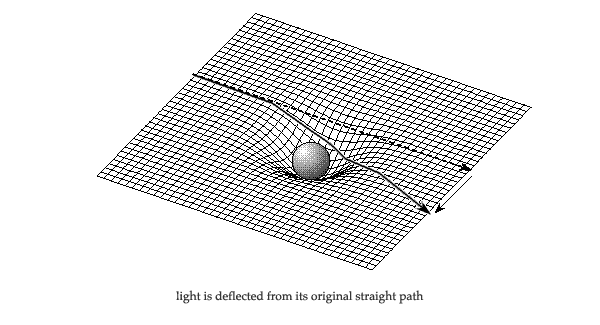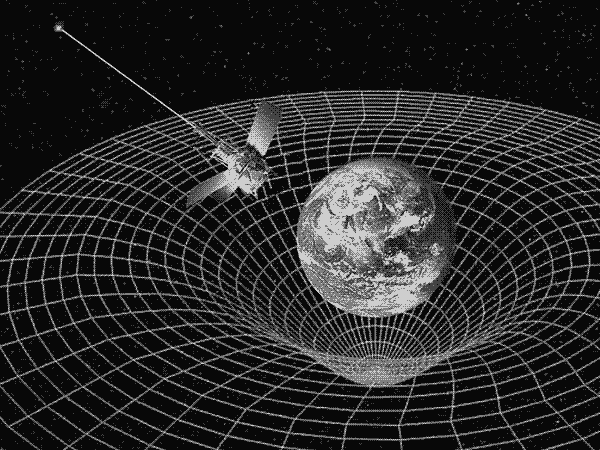Apparently Einstein kicked Newton’s butt, not once but twice. Special Theory of Relativity (in 1905) showed that Newton’s Three Laws of Motion were only approximately correct, breaking down when velocities approached that of light. And General Theory of Relativity (in 1915, or early 1916?) showed that Newton’s Law of Gravitation was also only approximately correct, breaking down when gravitation becomes very strong.
In Newton’s second law of motion, an object’s mass is measured by seeing how much it resists a change in motion (its inertia). In Newton’s law of gravity, an object’s mass is determined by measuring how much gravity force it feels. The fact that the two masses are the same is why Galileo found that all things will fall with the same acceleration.
Einstein, who won the Nobel Prize in Physics in 1921, didn’t believe gravity was a force at all; he said it was a distortion in the shape of space-time, otherwise known as “the fourth dimension”.
From the description of the book Relativity: The Special and the General Theory:
General relativity or the general theory of relativity is the geometric theory of gravitation published by Albert Einstein in 1915. It is the current description of gravitation in modern physics. General relativity generalises special relativity and Newton’s law of universal gravitation, providing a unified description of gravity as a geometric property of space and time, or spacetime. In particular, the curvature of spacetime is directly related to the four-momentum (mass-energy and linear momentum) of whatever matter and radiation are present.
The relation is specified by the Einstein field equations, a system of partial differential equations. Einstein’s theory has important astrophysical implications. For example, it implies the existence of black holes-regions of space in which space and time are distorted in such a way that nothing, not even light, can escape-as an end-state for massive stars. There is evidence that such stellar black holes as well as more massive varieties of black hole are responsible for the intense radiation emitted by certain types of astronomical objects such as active galactic nuclei or microquasars.
Lawrence M. Krauss in his book, A Universe From Nothing: Why There Is Something Rather Than Nothing:
Einstein’s theory is not just a new theory of gravity, it was also the first theory that could explain not merely how objects move through the universe, but also how the universe itself might evolve.
On Astronomy 162, taught in The University of Tennessee, Knoxville:
Einstein’s Special Theory of Relativity is valid for systems that are not accelerating. Since from Newton’s second law an acceleration implies a force, special relativity is valid only when no forces act. Thus, it cannot be used generally when there is a gravitational field present.
The General Theory of Relativity was Einstein’s stupendous effort to remove the restriction on Special Relativity that no accelerations (and therefore no forces) be present, so that he could apply his ideas to the gravitational force. It is a measure of the difficulty of the problem that it took even the great Einstein approximately 10 years to fully understand how to do this. Thus, the General Theory of Relativity is a new theory of gravitation proposed in place of Newtonian gravitation.
From How Stuff Works:
Basic physics states that if there are no external forces at work, an object will always travel in the straightest possible line. Accordingly, without an external force, two objects travelling along parallel paths will always remain parallel. They will never meet.
But the fact is, they do meet. Particles that start off on parallel paths sometimes end up colliding. Newton’s theory says this can occur because of gravity, a force attracting those objects to one another or to a single, third object. Einstein also says this occurs due to gravity — but in his theory, gravity is not a force. It’s a curve in space-time.
According to Einstein, those objects are still travelling along the straightest possible line, but due to a distortion in space-time, the straightest possible line is now along a spherical path. So two objects that were moving along a flat plane are now moving along a spherical plane. And two straight paths along that sphere end in a single point.
Still more-recent theories of gravity express the phenomenon in terms of particles and waves. One view states that particles called gravitons cause objects to be attracted to one another. Gravitons have never actually been observed, though. And neither have gravitational waves, sometimes called gravitational radiation, which supposedly are generated when an object is accelerated by an external force.
Gravitons or no gravitons, we know that what goes up must come down. Perhaps someday, we’ll know exactly why. But until then, we can be satisfied just knowing that planet Earth won’t go hurdling into the sun anytime soon. Gravity is keeping it safely in orbit.
Einstein proposed in his General Relativity theory that what is called gravity is really the result of curved spacetime.

Einstein described gravity as a warping of spacetime around a massive object. The stronger the gravity, the more spacetime is warped.

Light travels along the curved space taking the shortest path between two points. Therefore, light is deflected toward a massive object! The stronger the local gravity is, the greater the light path is bent.
Einstein’s theory is not perfect (no scientific theory is absolutely perfect), but it does give a better understanding of the universe.
Two key predictions of Albert Einstein’s general theory of relativity have been confirmed by NASA’s Gravity Probe B mission.

(An artist’s concept of Gravity Probe B orbiting Earth, which is warping spacetime/NASA)
The first is the geodetic effect, which is the warping of space and time—or spacetime—around a gravitational body, such as a planet.
The second effect of gravity tested by Gravity Probe B is frame dragging, which is the amount that a spinning object pulls the fabric of spacetime along with it.
OOT: I didn’t know that we have so many dimensions (also known as hyperspace), we have (at least) seven dimensions, including one for time! Unfortunately we cannot fully envision them. I’ll get back to this in future blog posts.